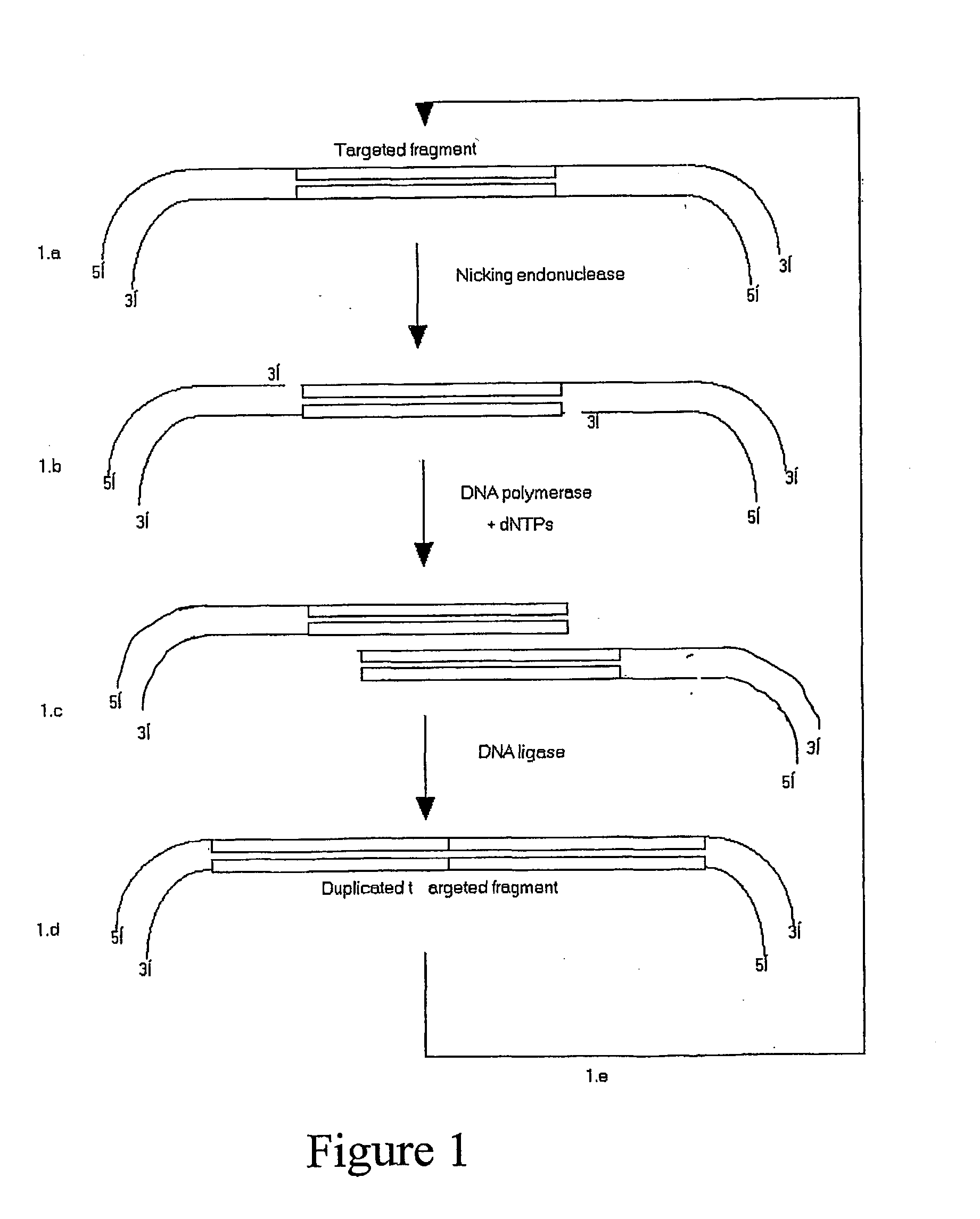Concatenated nucleic acid sequence
a nucleic acid sequence and concatenation technology, applied in combinational chemistry, chemical libraries, sugar derivatives, etc., can solve the problems of insufficient protein diversity from distantly related building blocks, clone dna fragments in the form, and concatenation of oligonucleotide primers without control of the number of fragments per concatamer, etc., to facilitate the design of metal sensing
- Summary
- Abstract
- Description
- Claims
- Application Information
AI Technical Summary
Benefits of technology
Problems solved by technology
Method used
Image
Examples
example 1
One Cycle of Concatenation on a Randomised 84-bp DNA Sequence
[0094] By PCR, two N.BstNBI sites (one at each end and in opposite orientation) were appended to a 84-bp DNA sequence encompassing the randomised V.sub.H-CDR2 of a synthetic repertoire of human ScFV, pIT2-I repertoire (Tomlinson et al.), which was subsequently cloned into pK4, a phagemid vector devoid of N.BstNBI sites (repertoire size: .about.10.sup.3 clones) (FIG. 2.a). To perform a cycle of concatenation, a three-step approach was followed:
[0095] Incubation of pK4-V.sub.H-CDR2 with N.BstNBI to create a single-stranded DNA nick at the 5'-end of each DNA strand of the 78-bp target sequence. Agarose gel analysis of the "nicked" DNA confirmed a change in electrophoretic mobility when compared to untreated DNA.
[0096] The second step aims at filling the 5'-overhangs with nucleotides in presence of a DNA polymerase. Best results were obtained with Klenow Fragment of DNA polymerase I (at 37.degree. C.) but other polymerases exh...
example 2
Four Cycles of Concatenation on a Randomised 84-bp DNA Sequence
[0099] The above described method can be repeated several times on the same DNA template. Indeed, after a first cycle of duplication, the N.BstNBI sites are not destroyed, no additional N.BstNBI sites have been created, and the concatenated DNA sequences are still comprised within the pK4 plasmid. This opens the possibility to further concatenate target nucleic acid sequences by performing several sequential cycles of concatenation (FIG. 3).
[0100] Thus, double-stranded DNA was prepared from the pooled transformants obtained after the first cycle of duplication (see Example 1) and a cycle of concatenation was performed as described in Example 1. PCR screening of 28 transformants revealed 23 clones (82%) carrying a concatenated DNA sequence of expected length (4.times.84-bp=336 bp). SpeI digestion of all positive clones confirmed the presence of three SpeI sites (two resulting from the duplication of the SpeI site created ...
example 3
Construction of Encoded Concatenated Polypeptide Repertoires
[0104] The potential of the present invention was further evaluated by constructing encoded concatenated polypeptide repertoires of much larger complexities (.gtoreq.10.sup.7 individual clones). First, randomised 6-and 15-residue peptide repertoires were constructed by cloning a 18-bp randomised DNA fragment and a 45-bp randomised DNA fragment (using NNK codons) into pK10-AmbS and pK10-2AmbS. The synthetic DNA fragments were designed such that the 18-bp and the 45-bp target DNA sequences were encompassed by two N.BstNBI nicking sites in opposite directions. Both sites were positioned such that (1) upon nicking, the 5'-overhangs would only comprise the target DNA sequence and (2) the nicking sites are located at the junction between coding triplets. The repertoires (herein named pK10-1.times.6-mer and pK10-.times.15-mer) of greater than 5.times.10.sup.8 ampicillin-resistant clones were obtained in E. coli TG1 cells. Greater ...
PUM
| Property | Measurement | Unit |
|---|---|---|
| temperature | aaaaa | aaaaa |
| temperature | aaaaa | aaaaa |
| temperature | aaaaa | aaaaa |
Abstract
Description
Claims
Application Information
 Login to View More
Login to View More - R&D
- Intellectual Property
- Life Sciences
- Materials
- Tech Scout
- Unparalleled Data Quality
- Higher Quality Content
- 60% Fewer Hallucinations
Browse by: Latest US Patents, China's latest patents, Technical Efficacy Thesaurus, Application Domain, Technology Topic, Popular Technical Reports.
© 2025 PatSnap. All rights reserved.Legal|Privacy policy|Modern Slavery Act Transparency Statement|Sitemap|About US| Contact US: help@patsnap.com



